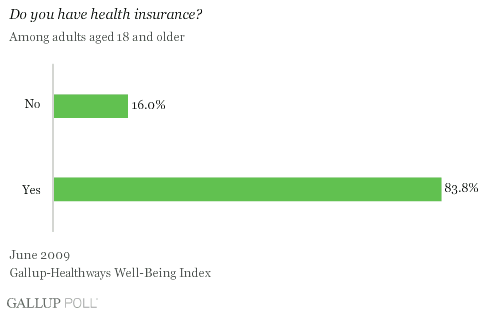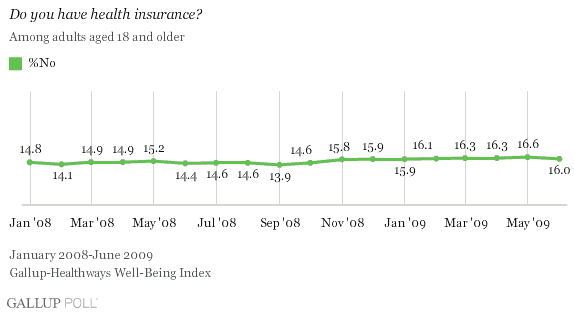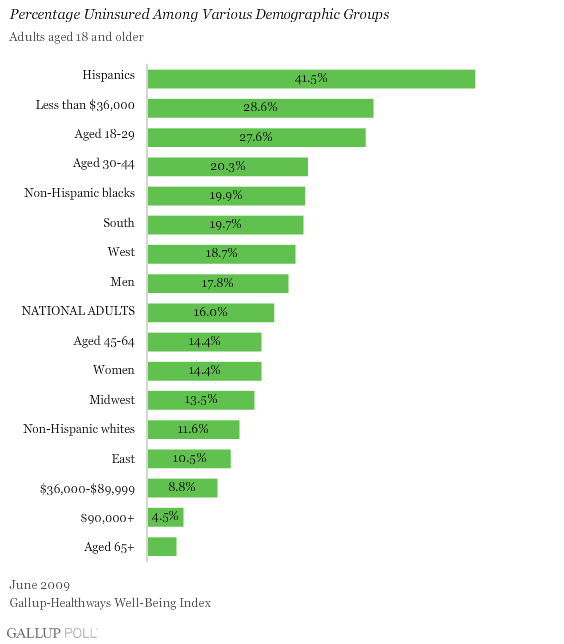WASHINGTON, D.C. -- As congressional lawmakers debate healthcare reform legislation, partly aimed at expanding coverage to the uninsured, Gallup-Healthways Well-Being Index data for June reveal that 16.0% of American adults are currently without health insurance.

The June 2009 data encompass more than 29,000 daily tracking interviews of Americans aged 18 and older. Trend data show a small but measurable uptick in the percentage of uninsured adults over the last year and a half. The percentage uninsured averaged 14.8% among the approximately 350,000 adults interviewed in 2008, and rose to 16.2% among the 178,000 adults interviewed in the first six months of this year.

In the months before November 2008, the percentage without health insurance ranged from a low of 13.9% to a high of 15.2%. From November 2008 through May 2009, ���۴�ýfound increases in the percentage of Americans reporting that they did not have coverage -- with the percentage uninsured reaching a high of 16.6% in May, before dropping down to 16.0% in June.
The latest official estimate of healthcare coverage from the is for 2007, and reveals that 15.3% of all Americans (including children) are without insurance. This translates into the oft-cited figure of 46 million Americans without insurance. The Census figures show that those under 18 are more likely to be insured than those 18 and older, and extrapolations of the Census data suggest that the percentage of adults aged 18 and older without insurance in 2007 would be close to 17%. Given Gallup's estimate that the percentage uninsured has risen by about a percentage point in the first half of 2009 compared to 2008, it would not be surprising if the Census figures for 2009, when available, show an increase in the percentage who are uninsured compared to earlier years.
Demographics of the Uninsured
With an aggregated sample of more than 29,000 interviews in June, ���۴�ýis able to report an up-to-date indication of segments of the adult population with the highest percentage uninsured. At 41.5%, Hispanic Americans are, by a significant margin, the demographic segment of the adult population most likely to be uninsured. Non-Hispanic black Americans are also significantly more likely than non-Hispanic white Americans to be uninsured, 19.9% vs. 11.6%. There is a strong relationship between age and income and health insurance coverage, with younger and low-income Americans significantly more likely to be uninsured than others. In fact, the two groups with the highest uninsured rates, other than Hispanics, are Americans who make less than $36,000 per year and those aged 18-29, with 28.6% and 27.6% uninsured, respectively.

Those aged 65 and older, and thus eligible for Medicare, are among the least likely to be uninsured, at 3.6%. High-income Americans, making $90,000 or more annually, also have high rates of health insurance coverage, with only 4.5% uninsured -- far below the national average of 16.0%. In terms of region, those in the South and West are more likely than Americans in the East and Midwest to be uninsured.
Bottom Line
The Gallup-Healthways Well-Being Index finds that while a large majority of Americans have health insurance, one in six in this country is without coverage. The current percentage of uninsured Americans (16.0%) represents a small, but measurable increase over last year. Hispanic Americans, at a rate approaching triple the national average, are the most likely subset of the population to be uninsured. Those making less than $36,000 per year are the second-most-likely group to be uninsured, with 18- to 29-year-olds following closely behind.
Survey Methods
For the Gallup-Healthways Well-Being Index, ���۴�ýis interviewing no fewer than 1,000 U.S. adults nationwide each day. Monthly results comprise roughly 30,000 interviews. For results based on these samples, the maximum margin of sampling error is ±1 percentage point.
Interviews are conducted with respondents on land-line telephones (for respondents with a land-line telephone) and cellular phones (for respondents who are cell-phone only).
In addition to sampling error, question wording and practical difficulties in conducting surveys can introduce error or bias into the findings of public opinion polls.
About the Gallup-Healthways Well-Being Index™
The Gallup-Healthways Well-Being Index is the first and largest survey of its kind, with 1,000 calls a day, seven days a week. It is the official statistic for Wellbeing in America, giving a daily measure of people's wellbeing at the close of every day, based on the World Health Organization (WHO) definition of health as not only the absence of infirmity and disease but also a state of physical, mental, and social wellbeing. The Well-Being Index will be a daily measure determining the correlation between the places where people work and the communities in which they live, and how that and other factors impact their wellbeing. Additionally, The Well-Being Index will increase the understanding of how those factors impact the financial health of corporations and communities. For additional information, go to .
